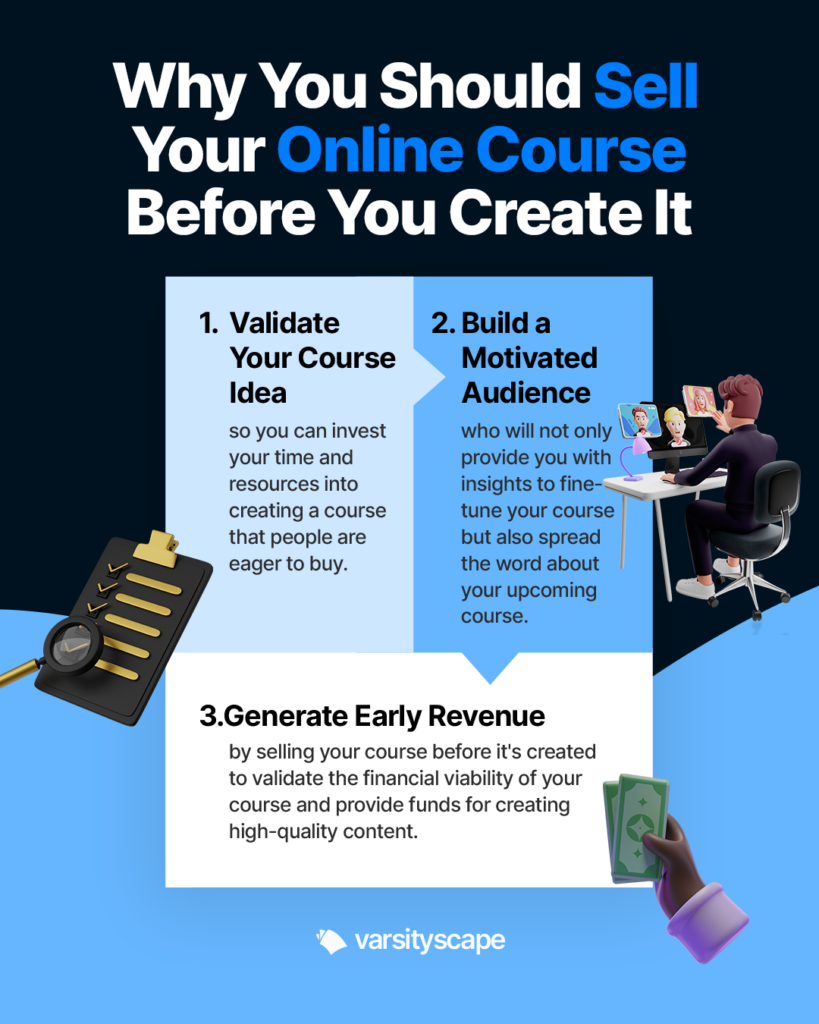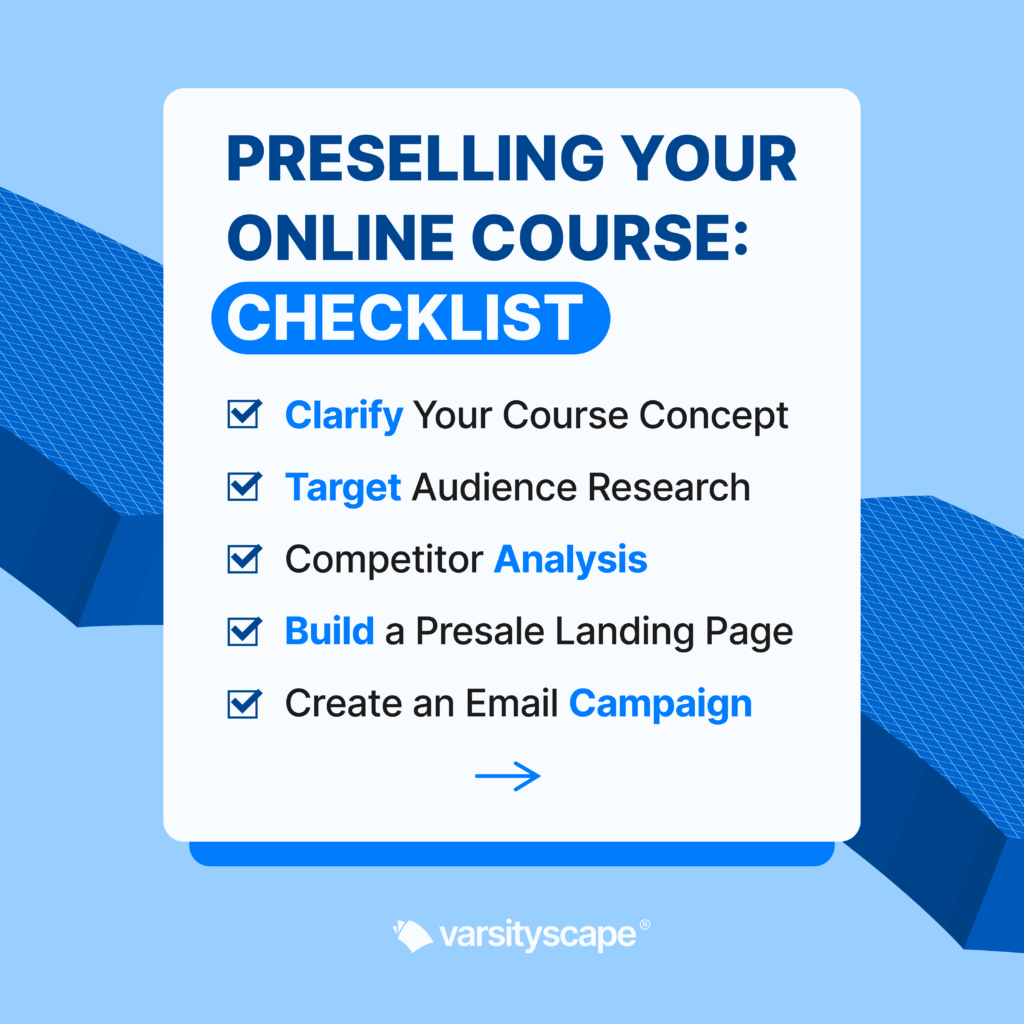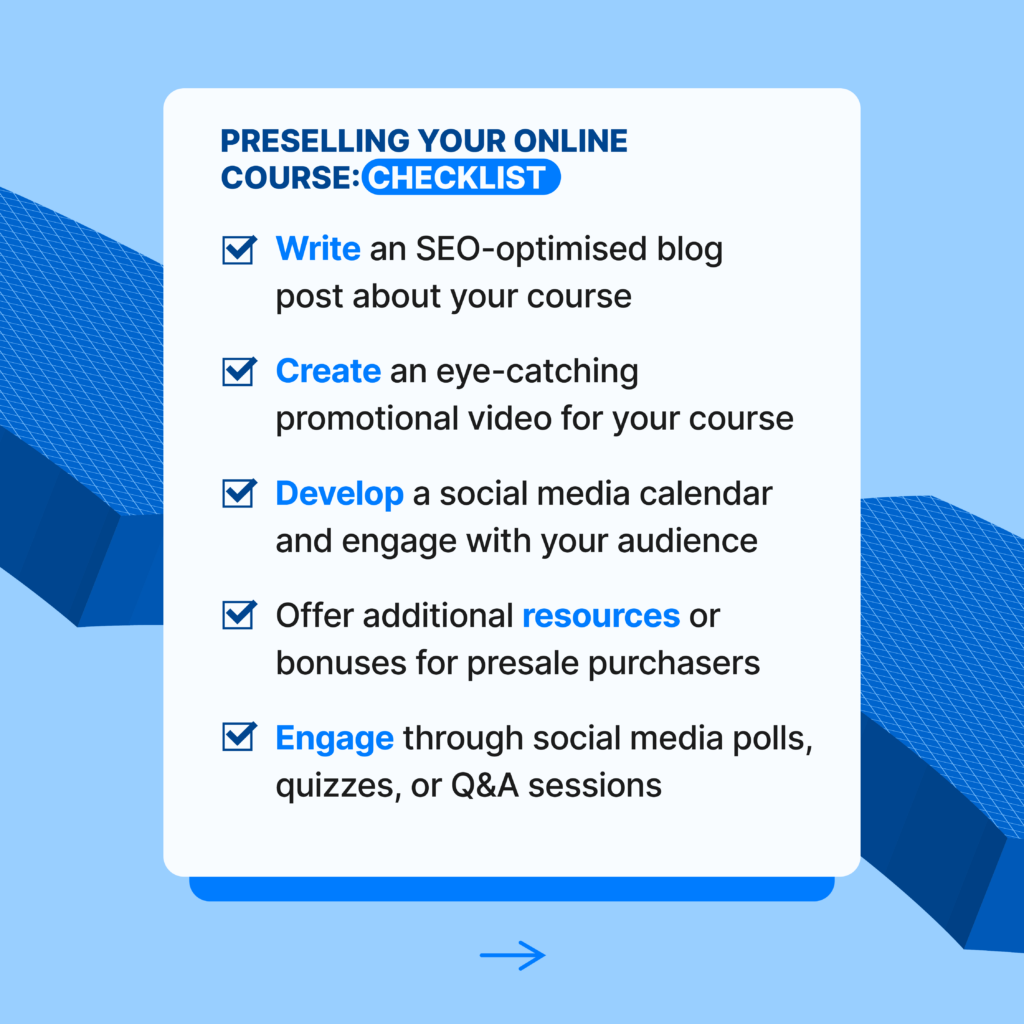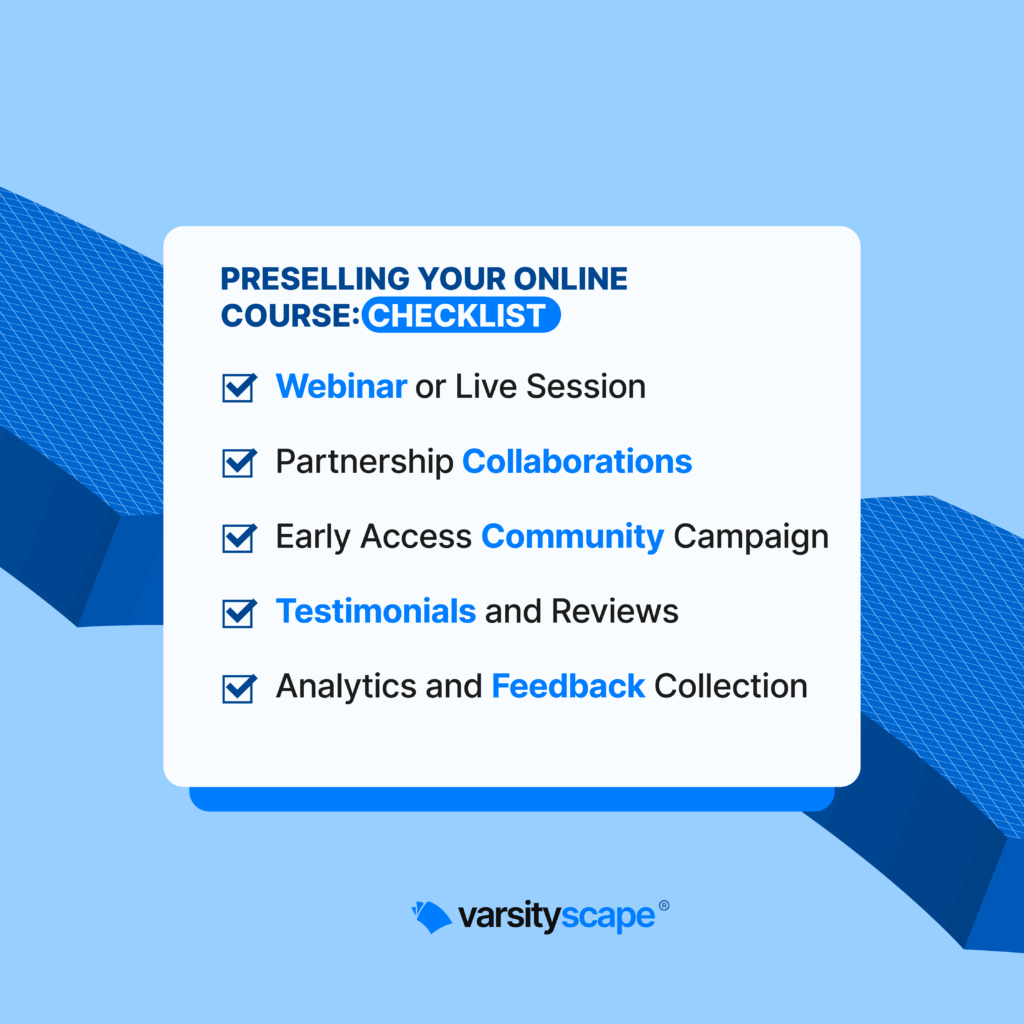
If you’ve ever thought of creating an online course, you know how crazy the decision-making process can be. From picking the perfect course topic to buying recording equipment, selecting an apt course title, and even the art of marketing, there are so many choices.
And as you’re busy struggling with all this, you’ve probably found yourself grappling with the big decision of slapping a price tag on your work. We get it – it’s a challenging decision to make.
Now, here’s the thing: what if there was a way to not just sell your course but turn it into a literal revenue-generating system?
Many course creators make the mistake of neglecting to plan how they will actually sell their course. As a result, they unintentionally run the risk of launching a course that generates minimal (if any) sales once it’s published.
Pre-selling is the key to mitigating this risk and ensuring the success of your online course. By pre-selling, you have the opportunity to gauge interest, validate your course idea, and build a motivated audience before you invest significant time and effort in course creation.
In this article, I will guide you through the process of pre-selling your online course – from planning your pre-launch strategy to executing effective marketing techniques. We’ll explore the benefits of pre-selling, how to generate buzz and anticipation, and the tactics to convert interested prospects into actual customers.
You’ll learn how to create a course that meets the needs of your target audience and resonates with your audience, while generating the sales success you desire.
Why should you keep reading? Well, because we’ll discuss:
1. Why Preselling Works: We’ll explore how it transforms your course from a hidden gem to a sought-after treasure and why it’s the best strategy to create anticipation and demand for your new course.
2. Crafting a Compelling Offer: We’ll break down the steps to create an enticing offer that not only your audience can’t resist but one that you’ll be excited to present.
3. Building Your Tribe: Selling a course? Nah, we’re all about building a community. You’ll learn how to use webinars and emails to gather enthusiasts who can’t wait to see your course.
4. Launching Without the Headache: Launching your course doesn’t have to be a headache. We’re guiding you through the process, making sure your grand reveal is a success without the overwhelm.
Why You Should Sell Your Online Course Before You Create It
Selling your course before it’s even created may sound counterintuitive, but it holds immense benefits that can significantly impact the success of your course launch. Here are a few reasons why you should consider pre-selling:

1. Validate Your Course Idea: Pre-selling allows you to test the market demand and validate your course concept. By presenting your course idea to potential customers and gauging their interest, you can ensure that there is a genuine desire for the knowledge you’re offering.
This validation process ensures that you invest your time and resources into creating a course that people are eager to buy.
2. Build a Motivated Audience: Pre-selling enables you to build a community of engaged learners before your course is even launched. As you interact with potential customers during the pre-sale phase, you have the opportunity to nurture relationships, gather valuable feedback, and develop a loyal following.
This motivated audience will not only provide you with insights to fine-tune your course but also become your advocates, spreading the word about your upcoming course launch.
3. Generate Early Revenue: By selling your course before it’s created, you can generate early revenue to support the development process. This upfront income not only validates the financial viability of your course but also provides the necessary funds for creating high-quality content, investing in marketing efforts, or enhancing the overall learning experience.
Pre-selling can be a fantastic way to secure the necessary resources to deliver a top-notch course to your customers.
In marketing, understanding the difference between “want” and “need” is necessary to effectively promote and sell your online course. While the terms may seem similar, they tap into different aspects of human motivation and desire.
“Needs” pertain to the essential requirements and necessities that individuals must have in their lives. While needs are important, they may not create a strong emotional pull or sense of urgency in the context of marketing an online course.
On the other hand, “wants” are desires, aspirations, or things that individuals crave but can live without. When selling your course, appealing to your audience’s wants can be highly effective in stirring their interest, capturing their attention, and ultimately motivating them to make a purchase.
To successfully market your online course, it’s essential to understand the wants of your target audience.
What are their desires, goals, and aspirations? What are the pain points they are seeking to address or the benefits they wish to achieve?
By aligning your course offering with the wants of your audience, you can create marketing messages that resonate deeply, evoke emotions, and inspire action.
Stay tuned for the next section, where we’ll explore effective strategies to identify and tap into the wants of your target audience, helping you craft compelling marketing campaigns that drive sales and make your course irresistible.
Before you read about the strategies and back-end marketing processes for your pre-selling process, here are 20 quick tips to serve as a check-list for you:

- Clarify Your Course Concept:
- Define the core purpose of your course.
- Identify the unique value and benefits it offers.
- Target Audience Research:
- Conduct detailed research on your target audience.
- Understand their pain points, desires, and learning preferences.
- Competitor Analysis:
- Analyse competitors in your niche.
- Identify gaps in the market and areas where your course excels.
- Craft a Compelling Offer:
- Develop an irresistible offer for early adopters.
- Consider exclusive bonuses or early access to incentivize presales.
- Build a Presale Landing Page:
- Design a dedicated landing page for your presell.
- Clearly communicate the benefits and features of your course.
- Email Campaign Creation:
- Develop a strategic email campaign to generate interest.
- Craft engaging email content that highlights the value of your course.
- Newsletter Integration:
- Use your newsletter to keep your audience informed.
- Regularly update subscribers on presale progress and exclusive content.
- Content Marketing Blitz:
- Write a detailed blog post about your course.
- Leverage SEO to increase visibility and attract potential presale customers.
- Visual Appeal:
- Create an eye-catching promotional video for your course.
- Share the video on platforms like YouTube to reach a broader audience.
- Social Media Strategy:
- Develop a social media calendar for presale promotion.
- Engage with your audience on platforms like Facebook, Twitter, and Instagram.

- Bonus Offerings:
- Consider offering additional resources or bonuses for presale purchasers.
- Highlight these extras in your marketing materials.
- Engagement Tactics:
- Foster engagement through social media polls, quizzes, or Q&A sessions.
- Create a sense of community around your course before it launches.
- Webinar or Live Session:
- Host a webinar or live session to discuss the benefits of your course.
- Allow potential buyers to ask questions and interact with you directly.
- Partnership Collaborations:
- Explore partnerships with influencers or complementary businesses.
- Leverage their audience to increase your presale reach.
- Early Access Campaign:
- Offer exclusive early access to a select group.
- Encourage these early adopters to share their experiences and testimonials.
- Email Drip Campaign:
- Set up an automated email drip campaign to nurture leads.
- Gradually provide more information about your course as the presale progresses.
- Testimonials and Reviews:
- Collect testimonials from beta testers or early adopters.
- Share positive reviews on your presale page and social media.
- Limited-Time Offers:
- Create a sense of urgency with limited-time offers.
- Encourage potential buyers to take advantage of special pricing or bonuses.
- Interactive Content:
- Develop interactive content such as quizzes or challenges related to your course.
- Use this content to engage your audience and build excitement.
- Analytics and Feedback Collection:
- Set up analytics to track the performance of your presale campaign.
- Collect feedback from your audience to improve future offerings.

The Perfect Strategies for the Pre-Selling Process
Now that we understand the importance of pre-selling and the basics of marketing, it’s time to dive into the step-by-step process of executing a successful pre-selling campaign for your online course. Following these strategies and tips will help you maximise your chances of a profitable course launch:
1. Build Buzz and Generate Interest: Create a buzz around your upcoming course by teasing its benefits, sharing snippets of valuable content, and offering a sneak peek into what your course will cover.
Use your existing social media platforms, email newsletters, and online communities to generate interest and engage with your target audience. Offer exclusive incentives, such as early bird pricing or limited bonuses, to entice potential customers to join your pre-sale list.
2. Clearly Articulate Your Value Proposition: Clearly communicate the unique value that your course provides. Highlight the specific problems it solves, the skills it develops, or the transformation it offers.
Focus on the outcomes and benefits your audience can expect to achieve by enrolling in your course. Craft persuasive marketing messages that resonate with their wants and aspirations, compelling them to take action.
3. Establish Trust and Credibility: Provide social proof to build trust and credibility. Share testimonials from satisfied customers or case studies showcasing the results others have achieved through your teachings.
Highlight any relevant credentials, expertise, or industry recognition you possess. By establishing yourself as an authority in your field, you instil confidence in potential customers, making them more likely to invest in your course.
4. Offer Irresistible Presale Bonuses: To encourage early purchases, offer exclusive bonuses or additional content that i) complement the main course, ii) provide extra value and iii) create a sense of urgency for potential customers to buy during the pre-sale period.
Make sure the bonuses are relevant and genuinely enhance the learning experience, enticing customers to take immediate action.
5. Engage with Your Pre-Sale Audience: Actively engage with your pre-sale audience by providing personalised attention and addressing their questions and concerns promptly.
You want to foster a sense of community by hosting live Q&A sessions or webinars where customers can connect with you and fellow learners.
This engagement not only builds a loyal customer base but also creates a feedback loop that helps you refine and improve your course content.
6. Close the Pre-Sale and Launch Quickly: As the pre-sale period comes to an end, create a sense of urgency to encourage final purchases. Offer limited-time discounts, countdown timers, or special incentives for those who take action before the deadline.
Once the pre-sale period concludes, deliver on your promises by launching your course with impact. Provide a seamless onboarding experience, high-quality content, and ongoing support to wow your customers and solidify their satisfaction.
By following these step-by-step strategies, you’ll be well on your way to a successful pre-selling campaign for your online course. Remember, pre-selling not only validates your course idea but also allows you to build a motivated audience, generate early revenue, and fine-tune your course content based on valuable feedback.
In the next section, we’ll explore effective marketing channels and tactics to promote your pre-sale and reach a wider audience.
How Do I Use Webinars and Email Lists for Pre-Selling Success

Webinars have proven to be a powerful tool for pre-selling online courses, allowing you to educate, engage, and convert potential customers. Here’s how to make the most of webinars in your pre-selling strategy:
- Create a Compelling Webinar Topic: Choose a webinar topic that aligns with your course and addresses a specific pain point or desire for your target audience. Draw up a relatable title and a captivating description that grabs their attention and compels them to register.
- Provide High-Value Content: During the webinar, deliver valuable content that gives attendees a taste of what they can expect from your course. Share actionable tips, insights, or strategies that showcase your expertise and leave participants wanting more. This builds trust and positions you as an authority in your field.
- Engage and Interact: Encourage active participation during the webinar by incorporating polls and interactive exercises. This engagement not only keeps attendees hooked but also allows you to gather valuable feedback and insights on their needs and preferences.
- Pre-Selling Offers: Towards the end of the webinar, make a compelling offer to pre-sell your course. Provide exclusive discounts, bonuses, or early access for those who take action during the webinar. Create a sense of urgency to drive immediate conversions.
In addition to webinars, leveraging your email list is a powerful way to maximise your pre-selling efforts. Here’s how:
- Build an Engaged Email List: Develop a targeted and engaged email list by offering valuable lead magnets, such as e-books, checklists, or mini-courses, to attract potential customers. Nurture this list by regularly providing relevant content, updates, and exclusive offers.
- Pre-Launch Email Sequences: Prior to your pre-sale launch, create a series of strategically crafted emails to generate anticipation and excitement. Provide valuable insights related to your course topic, share testimonials, and offer exclusive previews or bonuses to your email subscribers.
- Personalised Communication: Tailor your emails based on the interests and engagement levels of your subscribers. Segment your email list to deliver more personalised messages and offers. Use automation tools to schedule and track the effectiveness of your email sequences.
By combining the power of webinars and email lists, you can enhance your pre-selling campaign, engage with potential customers, and increase conversions for your online course.

Conclusion
As you begin pre-selling your online course, you need to remember that not every idea or target audience will be a perfect fit. If you find that there is minimal interest in your course topic, consider testing different topics or reaching out to a different target audience.
Sometimes, a great course idea may simply need to be presented to the right people to generate enthusiasm and sales.
Launching a pilot course can also be a smart approach. By involving students in the creation process, gathering their feedback, and addressing their questions, you can refine and improve your course. When you launch the final version at a higher price, you can be confident that it will be a hit, backed by the valuable input of real customers.
By following the strategies and tips outlined in this article, you can set yourself up for a successful pre-selling campaign and increase your chances of a profitable course launch.
So, that’s it. We hope you get to connect with your target audience, and start (or establish) your creator journey as you share your knowledge and expertise through your online course.
Good luck and happy pre-selling!



